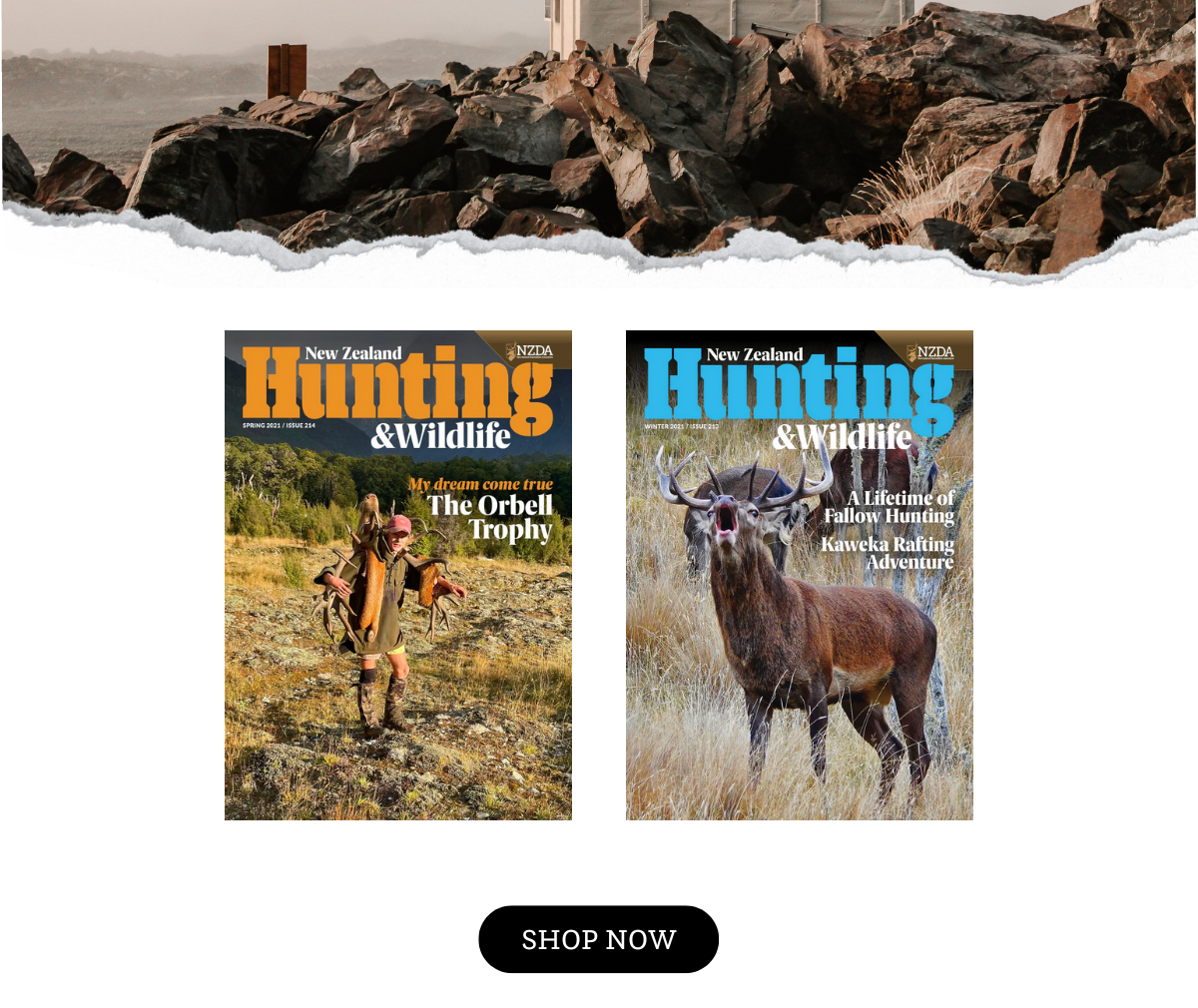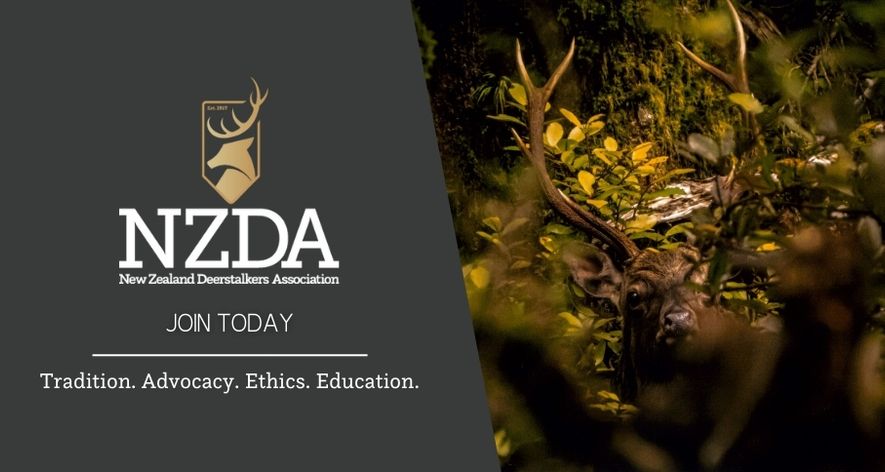2 August 2023
Hunting and Wildlife Magazine - Summer Issue 219
Words By: Blair Scotland
Back in 2019, I decided to take the plunge and book a 14-day Alaskan hunt chasing moose and Dall sheep. My friend Brian had talked me into this once in a lifetime hunt, having had quite a lot of success there previously. His tales of plentiful game and hunting adventures in one of the most wild and remote parts of the world won me over, and I paid the sizeable deposit to the outfitter in preparation for a 2020 hunt. Except things didn’t quite go to plan.
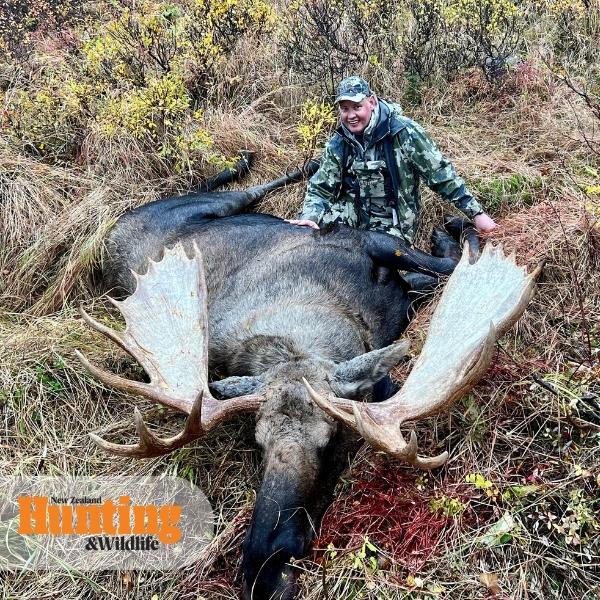
When my guide hissed “Get down and get your rifle” I knew this was the bull I was after!
Challenges
Enter COVID-19 and ensuing chaos. The hunt was off, the outfitter was unsure whether it would be back on, and messages from the US and Canadian governments were not particularly helpful. Combined with this, the hunting area in the Denali State Park was hit with two consecutive tough winters killing off a sizeable number of sheep. Things were not looking good for the hunt of a lifetime.
You can therefore imagine my surprise when two weeks before the opening of the hunting season, I received an e-mail from the outfitter that we were going ahead. Fortunately, I had taken the precaution of applying for the appropriate import and export paperwork to get my rifle into and out of Alaska. But for this, I would have had to have used the outfitter’s rifle. Interestingly, the US authorities were remarkably efficient, the NZ Police however less so. After a few calls to Air NZ and online bookings for internal flights and accommodation, and after packing and repacking my gear, my wife dropped me at Wellington airport, and I was off. Alaska here I come!
Four flights and a two-hour shuttle ride later, with a night in a hotel on the way, I had arrived in Healy, Alaska. After a day’s wait because of inclement weather, my phone lit up – ‘grab your gear, we’re heading into the hunting camp.’ I folded myself into the backseat of the Piper Cub bush plane and with a roar of the engine we were on our way. Half an hour later, I was at camp.
Hunting in Alaska
The laws relating to hunting in the US differ significantly from ours. Each state has its own regulations, with a defined legal hunting season for each species of game, and strict controls and requirements as to which animals can be harvested. For a “non-resident alien” like me, you have to hunt with a licensed guide, hold a hunting licence and harvest ticket issued by the Alaska Department of Fish and Game, and buy non-refundable metal locking tags that are attached to the animal if you are successful.
While most of the process can be undertaken online, the locking tags require you to physically purchase them in Alaska. I consulted with Brian who recommended I get myself down to Walmart on arrival in Alaska – this proved to be crucial advice, as without the tags there would be no hunt. $5000 later, I was ready to go.
While you can fly in a fixed wing bush plane into the state park, helicopters and motorised ground vehicles are not permitted. This means that once you are flown into one of the landing strips in the park, you’re either hunting on foot or on horseback. Given the immense scale of the country, I had booked a horseback hunt. It turned out to be the right way to go but was not without its challenges.
The style of hunting itself is more familiar to kiwis. Essentially, it’s a case of get up high, spot an animal, get closer to ensure that it is legal, and then stalk and (hopefully) take a shot. The licensed guide has to be with you at all times during the hunt and has to give you the go-ahead to shoot. Each hunter tends to have their own dedicated guide, with a ration of two hunters to one guide at most.
If you only wound the animal but don’t recover it, that’s the end of your hunt for that species.
Likewise, if you shoot an undersize animal, or even the wrong one, you not only forfeit your trophy of a lifetime, but risk facing a fine, and even prison time. As the thought of spending Christmas in an Alaskan state penitentiary did not sound particularly appealing, paying attention to the guide became a priority!
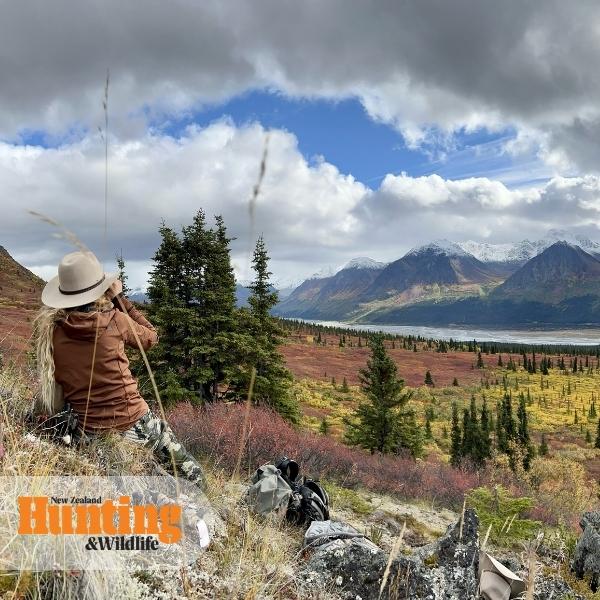
The beautiful country we were hunting was both vast and very remote.
Game species
As a keen deer hunter, moose was always a top priority for this trip. A legal bull moose must have an antler spread of over 50 inches, or at least four points on one brow tine. Like many species of deer, moose tend to be seen moving in the magic hours of dusk and dawn, often spending their days bedded down in thick spruce forests where they seem to disappear. During the rut however, the bulls start herding cows, giving hunters a fighting chance.
Only residents can shoot cows; both bulls and cows are prized for their tender and delicious meat. Alaskan law requires a successful hunter to take and use all the animal’s meat or face steep fines. The old hunter who came up with the adage “the work starts after the animal is on the deck” must have been a moose hunter, as skinning, quartering and carrying out a bull moose requires a lot of effort.
Dall sheep are, in my view, one of the prettiest game animals. Pure white with wide curling horns, they live in the snow-topped peaks and rocky draws of the Alaskan wilderness. While I managed to see 18 ewes and lambs on the trip, not one ram was spotted, likely due to the two previous harsh winters, as well as predation from wolves.
Our hunting area was traditionally populated by thousands of caribou (reindeer in Europe), and it was awesome to be able to see herds wandering through. Although I did not hold a tag for these majestic animals, other hunters in camp did, apparently the tags are quite hard to obtain.
The other main game species is brown bear, referred to as grizzly bears. Smaller than their Kodiak Island cousins, grizzly bears are no-less formidable. I was regaled in camp with tales of bear attacks (including the alarming advice that a bear will firstly crush your skull in its powerful jaws before turning its attention to your genitals). Our hunting area was particularly known for producing blonde coloured grizzlies, which are incredibly pretty. I had decided that if I came across one of these beautiful creatures, I would do what I could to take one, provided I could keep a reasonable distance to make a clean shot!
Hunters are also allowed to shoot up to five wolves in a season. Because they eat juvenile sheep, caribou and moose, the state government encourages hunters to keep their numbers under control. I was fortunate to see a wolf in the wild howling for its mate but did not take a shot.
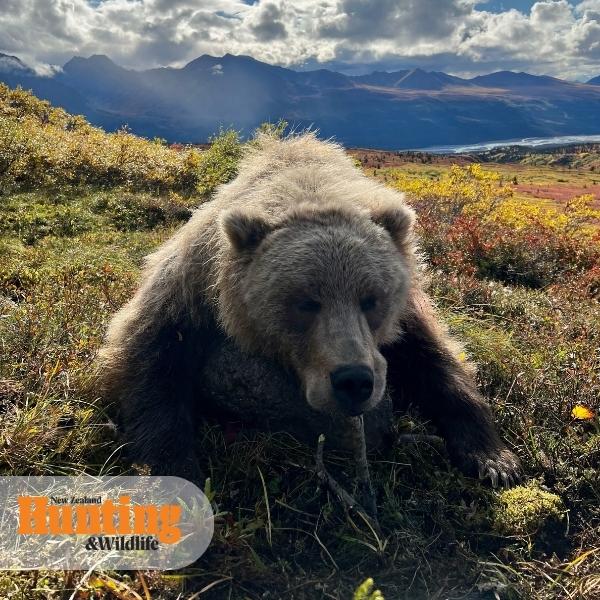
A buzz of excitement went through camp when a big blonde grizzly was spotted sniffing around the remains of a caribou on a faraway hillside, particularly when I got the go ahead to chase it down.
Camp life
In comparison to other hunting camps, I’ve spent time in, this one was fairly luxurious. Having a large and well-appointed camp meant that days when we were not hunting were still comfortable.
Based in the trees next to the airstrip, the camp was centred around a portable building containing food and equipment and two main canvas walled tents – one a dining area complete with wood burner, and the other the camp kitchen. The hunters had their own walled tent complete with its own wood burner for warming the occupants and drying gear, as well as stretchers and foam mattresses.
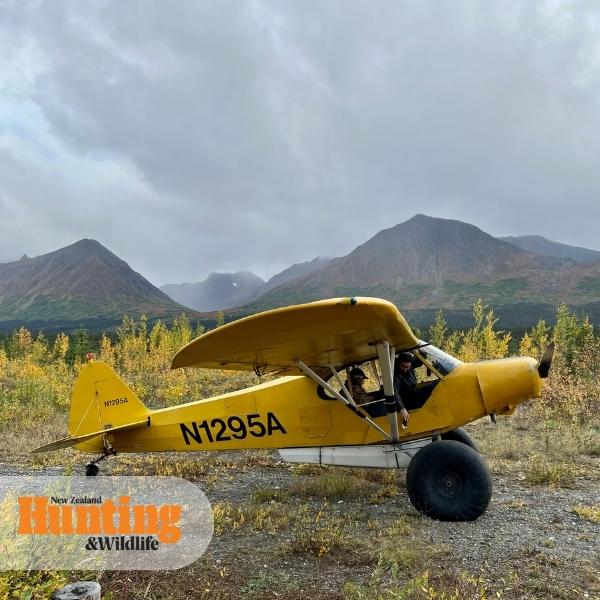
Half an hour after I folded myself into the backseat of the Piper Cub, I was at camp. These planes are amazingly versatile for getting around in the big Alaskan outback.
Other luxuries included fresh water pumped in from the nearby creek, a long drop, generator, and even a functioning shower. A hot shower proved a godsend after days spent on the hill in the cold and wet or having spent hours skinning and gutting animals.
The camp had its own dedicated cook and horse wrangler, who not only prepared fantastic meals for us all, but also assisted the guides in looking after the horses and pack mules. These hardy creatures require constant care and attention to get the best out of them.
Provisions were flown in on the bush plane when the weather permitted. This reinforced to me how far away you are from civilisation. It’s a half hour plane ride or a 12-hour horse ride over fairly unforgiving ground back to Healy. Therefore, if you have forgotten something, or something breaks or goes missing, you’re in trouble.
The hunt
Alaskan law prohibits you from hunting on the same day you land in camp, so after a false start the next day, it came time for me to meet the horse that had been selected for me. Ricky was a big unit, as were his colleagues, making getting onboard an interesting process! There is no way that I could claim to be a graceful equestrian, and while I would admit to being sore after a day’s riding, at least I didn’t fall off onto my backside.
The beauty of using horses is that they allow you to cover a lot more ground, they will carry your rifle and daypack, and allow you to more easily pack out an animal if you are successful. In general, the horses were even tempered, gentle and used to novice riders. However, that all goes out the window when they unexpectedly run into a bear – another hunter was bucked off his horse when a 7-foot grizzly appeared out of the timber 20 metres away. Fortunately, both horse and rider were unhurt.
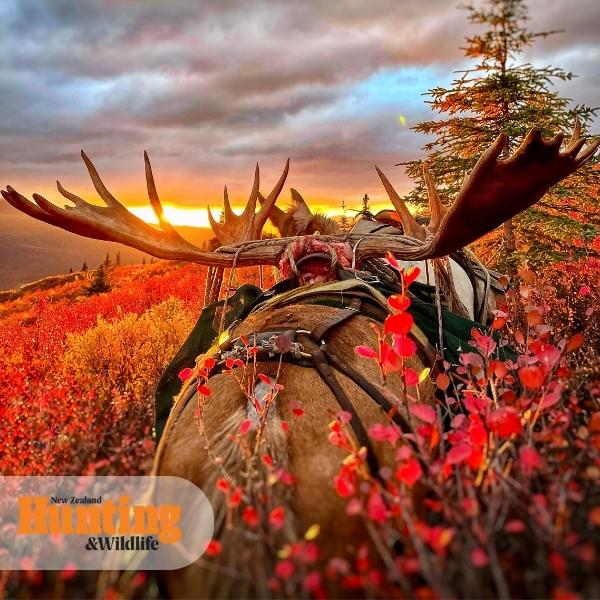
The beauty of using horses is that they allow you to cover a lot more ground, they’ll carry your rifle and daypack, and allow you to more easily pack out an animal if you are successful.
Interestingly, although an outfitter may regularly base themselves in a particular area, their territory is by no means exclusive. Other bush planes regularly buzzed around the valley dropping off and picking up resident hunters. It was thanks to one such group of successful residents that I was able to get my first animal on the deck.
Three young hunters had been flown into a neighbouring airstrip to hunt caribou and then pack raft down the river back to Healy. They had managed to shoot a nice animal on the side of a mountain, and we were able to see the gut pile from camp through spotting scopes. You can imagine the buzz of excitement that went through camp when a big blonde grizzly was spotted sniffing around the caribou’s remains, particularly when I got the go ahead to chase it down.
The plan was relatively simple – load up the horses and gear, get up the hill, then put a stalk on the bear. However, there’s a reason why it’s called hunting. By the time we got the horses up the hill and tied up, the bear was nowhere to be seen. We settled down in a good spot to watch the area, only to hear a single gunshot down the valley from another hunter from our camp. Buoyed by the hope that they had been successful, we soon saw a lone wolf howling on the skyline. That sound was haunting to say the least.
Soon the wolf got wind of the same caribou carcass that the bear had been interested in and made its way down the mountain to see what was left. After a couple of hours of waiting and glassing, we decided that the bear had departed, and that we should go over and get a closer look at the wolf. I was not overly keen on shooting one of these creatures but was certainly interested in seeing one up close. We commenced the two mile walk after lunch to get into a better position.
About halfway there, my guide stopped in his tracks and hissed “the bear’s back!”. The big blonde figure of a grizzly could be seen through the naked eye walking up out of a gully. Instantly we switched to stalking mode, using as much of the natural cover as possible to get closer to the animal. Fortunately, the wind stayed in our favour, and after about an hour I was in position to take a prone uphill shot from 300 metres. Pushing aside thoughts of wounded bears attacking hunters, I launched a 165-grain projective from my .300SM through the shoulders of the bear, causing it to do a roly-poly down the hill. Animal down!
After waiting half an hour, we crept up the hill, guns at the ready. In a clearing of alders was a beautiful blonde grizzly sow! Her fur was incredibly long and soft. After the obligatory photos and skinning the animal out, we were back on the horses, returning back to camp for a well-deserved meal and beer by 9pm.
Fast forward four days, and we were onto a moose. Locating a legal bull had proven a challenge. Smaller bulls had been spotted from a distance, but nothing that could be taken. We had ventured into some new country the day before and encountered a smaller legal bull standing side-on at 100 metres – an easy shot even for me. While he had 5 points on his brow tine, he appeared relatively narrow in the antlers to my untrained eye. My guide confirmed this, and I made the call to pass on the small bull. I immediately wondered if I would live to regret that decision.
Communication with your guide is key. Not only do they have to locate a legal animal, but they need to be able to get you to that animal so you can safely and humanely take it. They also need to be sure it is the animal you want to take. I told my guide that if we saw a legal bull moose that he estimated was over 55 inches in antler spread then to just tell me and I’d take the shot.
We continued along a high bench overlooking a spruce forest for a couple of hours until we found a rocky outcrop that enabled us to glass a lot of country. After a freeze-dried meal, we spotted a larger bull in the trees at about 450 metres. From the little we could see, he looked like the real deal as he threaded in and out of the timber, chasing a cow. However, within a matter of minutes of catching sight of him, he was gone. We waited around for a couple of hours until dusk, but he did not reappear. The only consolation was that he had not been in a shootable position.
The next day the call was made to go back to the same spot and see if the big bull would come out. By 6pm, there was no sign of him, so we mounted up and started heading slowly back to camp. As I got back on Ricky, the guide exclaimed “there’s good hunting to be had back along this trail”. How right he was! We had travelled along about 300 metres into a copse when all of a sudden, I could see that something had really got the guide’s attention. “Get down and get your rifle”. Given our previous communication I knew this was the bull I was after!
I got myself into position to take a 300-metre downhill shot, with the bull facing straight on from in between some trees. While by no means the ideal shot or shooting position, I squeezed off a round and was confident that I had connected. The animal didn’t go down! It stepped out again from behind a tree and I gave him another one – still no animal down. He appeared hit but wasn’t coming out from behind the trees. My guide took off along the track to see if he could get a better angle on the swaying creature who was clearly not feeling well. With one shot from the new angle the animal toppled. After obligatory photos, the real work began!
We skinned and gutted the moose, quartered it, and then covered the meat for recovery the next day. Even with three of us working on the animal, we still got back to camp at 2am. The next day we took four mules to pack out the meat, skin and antlers on. It was clear that someone had visited the site the night before, with claw marks visible across the moose’s ribcage! The last mule to be loaded all of a sudden became nervous. Turning around, not 30 metres away was a grizzly on her hind legs looking at the free meal about to be spirited away and huffing and puffing. She looked less than amused.
You can tell that things are serious when the guides draw their pistols and tell you to get behind them. After a lot of shouting, the bear decided that discretion was the better part of valour and decamped back into the timber. We wasted no time in finishing and hurried back to the relative safety of camp by 11pm.
The next night we dined on moose eye fillet, which was absolutely delicious. Many people have commented to me about how good moose meat is to eat, and I can testify that they weren’t exaggerating!
With no sign of any shootable Dall sheep, my hunt was pretty much over. The bush pilot flew into camp a few days early with supplies and advised that if I wanted to be guaranteed to make my flight back home, I should probably come out with him. In 10 minutes, I was packed and ready to go. Fortunately, my decision turned out to be the right one, with snow and wind preventing any flights in and out of camp for the next five days. The skins and antlers will hopefully get sent out through a US taxidermist and expediter when the hunting season ends.
Alaska is not a place for the fainthearted, and it’s probably not a hunt I would immediately jump to do again, particularly given the cost and time involved. That said, it was a hunt of a lifetime, and I was incredibly lucky to take two great animals.
Top 5 suggestions
- Take lightweight, good quality hunting gear. Merino layers, rainwear, a lightweight down jacket and good gloves are essential. Anything by Sitka, Kuiu, Stone Glacier, First Lite etc will be fine. Bush planes have strict weight limits that make airlines look generous!
- Good range finding binoculars are important. Everyone in camp was using either Leica or Swarovski. Remember – the Americans range everything in yards, so sight in accordingly.
- Take a Garmin InReach, a power bank, and at least two head torches. Most camps don’t have satellite phones so having your own means of communication, particularly if your travel plans change, is important.
- You need to be able to shoot confidently from a variety of positions up to ranges of 400 metres. Using a detachable bipod, shooting sticks etc is a good idea. Suitable calibres include 7mm Rem Mag / WSM, .300 Win Mag / WSM, .30 Nosler, .300 PRC. .270 or .308 are probably too light.
- Get your paperwork in order before you go! Finding general information online about the documentation you will need is unfortunately not straightforward. Luckily, I was able to successfully navigate the confusing (and sometimes unhelpful) requirements. If in doubt, speak to someone who knows what to do!



